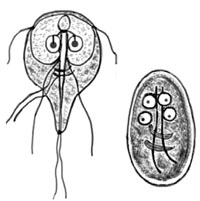34.1.2 Giardiasis
Giardiasis is a faeco-oral disease which results from infection of the small intestine by protozoa called Giardia intestinalis, also known as Giardia duodenalis. (Note: the same protozoa are called Giardia lamblia in older textbooks.) Studies have shown the prevalence of Giardia infection in Ethiopia ranges from 2.0% to 11.4% of the population. Like the parasitic amoebae described in the previous section, Giardia form resistant cysts in the person’s intestines (Figure 34.2) that pass out in the faeces. The cysts can be easily transmitted in water contaminated by faeces, from person-to-person through hand-to-mouth transmission and in food. They hatch out in the new person and the protozoa rapidly increase in number by cell division.

The commonest clinical manifestation of giardiasis is foul-smelling, pale, greasy diarrhoea, without blood or mucus (mucoid). The diarrhoea can be acute and resolve by itself within a few days, or it may be persistent (lasting for more than 14 days). Other symptoms of giardiasis include nausea, vomiting, abdominal cramps and abdominal distension (swelling).
Details of the specific management of children with persistent or severe diarrhoea are taught in the Module on the Integrated Management of Newborn and Childhood Illness.
You should suspect giardiasis in children if the diarrhoea is persistent, but not bloody or mucoid. For children with mild non-bloody or non-mucoid diarrhoea, the management does not require identification of the infectious agent; cases are managed with oral rehydration as already described for simple acute watery diarrhoea (refer back to Section 32.4.2). If a child has persistent or severe diarrhoea, and giardiasis is one of the causes you suspect, treatment is carried out at a higher-level health facility on a case-by-case basis, taking into account the presence of other symptoms and/or malnutrition. Therefore, you should start ORS treatment and refer the child.
In adults, you should suspect a diagnosis of giardiasis in cases with acute or persistent, non-bloody or non-mucoid diarrhoea. However, as other diseases could also have similar manifestations, confirmation of the diagnosis is needed through detection of the parasite in laboratory examination of stool samples. Therefore, start all adult patients on rehydration with ORS and refer them for further diagnosis and treatment.
Amoebiasis and giardiasis both present with diarrhoea. What is the difference in the type of diarrhoea resulting from the two diseases?
The main difference in the type of diarrhoea is that in amoebiasis it is bloody or mucoid (contains mucus), whereas in giardiasis it is pale, greasy and foul smelling.
34.1.1 Amoebiasis
